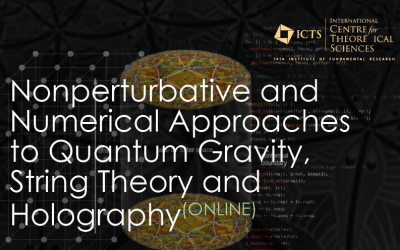Due to the ongoing COVID-19 pandemic, the original program has been postponed. This mini program is a precursor to the original program.
The goal of the second edition of the program ‘Nonperturbative and Numerical Approaches to Quantum Gravity, String Theory and Holography’ is to bring together theorists working in areas of lattice field theory, string theory and quantum gravity, to discuss the state of art nonperturbative methods and numerical approaches to tackle current and relevant research problems.
The program has strong pedagogical component as it also aims to build a growing community of theoretical scientists in India, to engage more in nonperturbative field theories interconnecting string theory, supersymmetric/superconformal field theories, quantum black holes, gravity, and holography.
This program can be broadly divided into the following five topics.
Lattice Supersymmetric Field Theories
Recent developments in realizing 4d N = 4 supersymmetry on a lattice (including ideas on regulating flat directions, static quark potential, anomalous dimension of Konishi operator and tests of S-duality), 4d N = 1 supersymmetry on a lattice (including fine-tuning of gluino mass, benchmark studies of confinement, gluino condensates and gluino-glueball spectrum), matrix models from sphere reductions of higher dimensional SYM.
Matrix Models, Quantum Black Holes, and Gravity
Recent developments in matrix model holography of type II string theories/M-theory/supergravity, precision gauge-gravity duality for quantum black holes via D0-brane quantum mechanics, Berkooz-Douglas matrix model for D0/D4-brane intersections, matrix models via large-N reductions as well as approaches to 2d SYM/WZ models.
Large N
Numerical studies based on large-N volume independence and Eguchi-Kawai (EK) reduction, meson, glueball spectra in large-N QCD, Twisted Eguchi-Kawai (TEK) reduction, mass anomalous dimensions in the large-N adjoint QCD and numerical studies of large-N 2d QCD.
Formal Developments on the Lattice
New approaches to solve sign problem (fermion bag approach, Lefschetz thimbles approach, complex Langevin dynamics with stochastic quantization and their numerical implementations), Resurgence and Trans-series in quantum mechanics and quantum field theory.
Quantum Information and Quantum Computation for Quantum Gravity/String Theory, Holographic Renormalization
Quantum information and quantum computation in the context of quantum field theory, string theory, holography, multi-scale entanglement renormalization ansatz (MERA), Tensor networks and Machine learning methods for AdS/CFT. The method of holographic renormalization, which is the gravitational counterpart of renormalization in QFT, is essential for obtaining well defined rules for computations in gravity/gauge theory duality and moreover it explicitly shows how spacetime is reconstructed from gauge theory data.
As an invitation to the main program, this mini program will include a series of research talks on the following topics and accompanying discussion sessions.
- Chiral Lattice Fermions from Staggered Fields by Simon Catterall (Syracuse University, USA)
- Asymptotic Freedom with Qubits by Shailesh Chandrasekharan (Duke University, USA)
- The Weak Cosmic Censorship Conjecture: Current Status by Pau Figueras (Queen Mary University of London, UK)
- Tensor Network Methods in Four Dimensional Field Theory by Daisuke Kadoh (National Center for Theoretical Sciences, Taiwan)
- Lattice Quantum Gravity and Asymptotic Safety by Jack Laiho (Syracuse University, USA)
- Complex Langevin Simulations of the Matrix Model for Superstrings by Jun Nishimura (KEK, Japan)
- Progress and Prospects of Lattice Supersymmetry by David Schaich (University of Liverpool, UK)
- Lattice Holographic Cosmology by Kostas Skenderis (University of Southampton, UK)
- Quantum Gravity in the Lab by Brian Swingle (University of Maryland, USA)
- Target Space Entanglement and Bekenstein Hawking Entropy by Sandip Trivedi (TIFR, India)
- Semi-Abelian Gauge Theories, Non-invertible Symmetry, and String Tensions Beyond N-ality by Mithat Unsal (North Carolina State University, USA)
Eligibility Criteria: Students and postdocs undertaking research in Quantum Gravity, String Theory, Holography and related fields are encouraged to apply. There is no registration fee.
 icts
icts res
res in
in
- Talks
- Title and Abstract
- Other links


